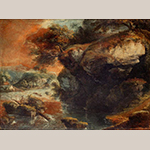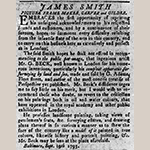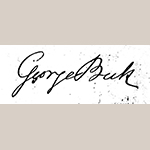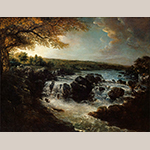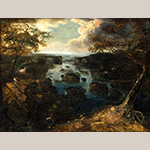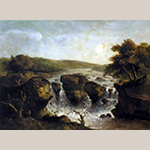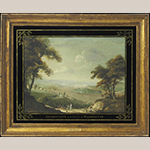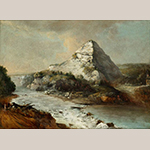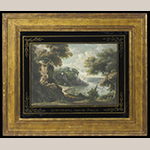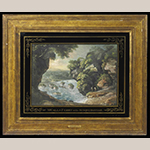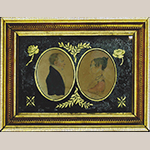Died — On the 14th of this month, after a long and tedious illness, Mr. George Beck, in the 64th year of his age… his eminence in landscape painting may rank him amongst the best painters of wild nature… but he languished here almost unnoticed… .[1]
In March of 1813, three months after the notice of George Beck’s death in the Kentucky Gazette, the auctioneer Daniel Bradford advertised in that newspaper that he would soon sell a choice collection of pictures by the late artist to benefit his widow, Mary Beck. “As the talents of Mr. Beck were so much neglected during his life,” Bradford advertised, “it is to be presumed that the citizens of Lexington will show their liberality and public spirit in purchasing these pictures… [which] are the only specimens of Mr. B.’s genius that they can ever have an opportunity of possessing.”[2]
Not all of the pictures sold. Over the next several years Mary Beck worked hard to promote her husband’s artistic legacy. Central to Mary Beck’s efforts was a biography of her husband that appeared in the August 1813 edition of the Portfolio, a Philadelphia arts journal.[3] The Portfolio’s “authorized” biography of George Beck has inspired, informed, and mislead, scholars of American painting for more than three quarters of a century. In 1940, the eminent Maryland historian J. Hall Pleasants was inspired by his discovery of the 1813 Portfolio biography to pen an essay on Beck for the Maryland Historical Magazine. In that essay, Pleasants noted that Beck had up until then “escaped the attention of all recent writers on early American painting.”[4] Three years later Pleasants included Beck in his 1943 book Four Late Eighteenth Century Anglo-American Landscape Painters.[5]
In 1969, Edna Talbot Whitley discussed Beck in an essay for the Register of the Kentucky Historical Society.[6] Both Pleasants and Talbot took the claims made in the Portfolio as fact. Deborah Thomas wrote an essay in 1992 for The Magazine ANTIQUES in which she surveyed Beck’s surviving oeuvre from an art-historical perspective.[7] Thomas relied heavily on the work of Pleasants and Whitley, but was the first scholar to note that some aspects of the Portfolio biography might be “fairly inaccurate and romantic.”[8] Most recently, Estill Pennington included a brief essay on Beck in the 2008 book Kentucky: The Master Painters.[9] [10]
Those seeking a complete account of Beck’s life or analysis of his paintings should consult the works of Pleasants, Thomas, Whitley, and Pennington. The intent of this research note is to update, and in some instances correct, the published biographies of George Beck, including the 1813 Portfolio memoir. By revisiting the historical record and introducing a recently discovered newspaper advertisement, a more accurate account of the artist’s career can be documented.
— ♦♦◊♦♦ —
Previously published sources have all cited George Beck’s career in America beginning in 1795, but an advertisement from Baltimore, Maryland reveals that he was actually present in America two years earlier.[11] On 19 September 1793, the Baltimore frame-maker James Smith advertised in the Baltimore Evening Post (Figure 1) that at his shop one could find:
that ingenious artist Mr. G. Beck, well known in London for his numerous inventions, particularly his complete apparatus for surveying by land and sea, made and sold by G. Adams, Fleet street, and author of the most concise treatment of perspective yet published. Mr. Beck’s diffidence urges me to say little on his merit, but I would wish to recommend those who doubt it, to revert to the criticisms on his paintings both in oil and water colors, that have appeared in the royal academy and other public exhibitions in London. He professes landscape painting, taking views of gentlemen’s seats, &c. surveying estates, and drawing plans thereof in so curious a manner as to show the faces of the country like a model of it painted in true colors, likewise history and portrait painting… .
James Smith’s praise for Beck and prominent listing of the artist’s noteworthy accomplishments suggest that Smith was quite enamored by the recently arrived painter—maybe too much. Beck did have a background in surveying, he understood the basics of perspective, and had shown his work at the Royal Academy of Arts; but neither a treatise on perspective written by Beck nor a surveying instrument designed by Beck and manufactured by G. Adams of Fleet Street—London’s leading instrument manufacturer—has been identified. And Beck’s work at the Royal Academy of Arts garnered little notice.[12]
Much of what has been published about George Beck’s life before his arrival in Baltimore comes from the Portfolio biography. Beck was born in Staffordshire, England, in 1750.[13] About 1776 he received an appointment to the British Army.[14] He had hoped for a professorship at the Royal Military Academy at Woolwich but was instead, through a series of unfortunate events and bad luck, “placed in the corps of engineers… (and ordered) to the Drawing Room in the tower of London where his powers were confined to the irksome employment of drawings plans and maps.”[15]
The Drawing Room was not the worst place for an aspiring landscapist to acquire a firm background in map work, surveying, and topographical rendering. The Drawing Room’s location in London placed Beck at the center of the English art scene and his tenure there coincided with a new educational regime at the Drawing Room that included lessons in architectural rendering and perspective by drawing master Henry Gilder.[16] Also, the artist Paul Sandby (1731-1809), called by one critic “the father of the topographical tradition in English landscape,” began his career in the Drawing Room, thirty years earlier, during the 1740s.[17] Indeed, Beck may have known Sandby through their mutual association with the Royal Academy of Arts.
George Beck spent a decade in the Drawing Room of the Tower of London, resigning in 1788 or 1789.[18] The artist’s earliest extant work dates to his draughtsman period: a pair of Devonshire views published in 1785 by the European Magazine.[19] The following year, he married a fellow artist, the French-born Mary Menessier. In 1787, Beck exhibited at the Royal Academy of Arts for the first time. Both George and Mary Beck also exhibited with the Society of Artists of Great Britain.[20]
According to the Portfolio biographer, in 1791 Beck was engaged to complete the illustrations for Antiquities of Ireland after the volume’s original artist and author, Frances Grose, died suddenly in Dublin. The claim for Beck’s appointment as Grose’s replacement was likely wishful thinking on the part of the Portfolio biographer, for he claims that the publisher “Mr. Hooper was suddenly taken ill, and died” and therefore the anticipated volume never materialized.[21] In fact, Antiquities of Ireland did materialize, completed by the artist Edward Ledwich under Hooper’s imprint in 1791.[22]
Upon losing the Antiquities of Ireland commission—or more likely never having had it—Beck embarked on a painting tour of England and Wales. The Portfolio biographer observed that:
The picturesque and romantic scenery of that country presented a school worthy of his genius. It was there, perhaps, he imbibed the energy and grandeur that distinguish his particular style. His bosom glowed with enthusiasm while he contemplated the sublimity of Snowdon, of Flinlimmon, and of Cader Idris. He was a votary of Nature and with a master-hand he transferred her mildest graces to his canvass.[23]
Following his sojourn across England and Wales, Beck was encouraged to visit America, according to the Portfolio biographer, where he “might find a theatre for the exercise of his powers.”[24]
— ♦♦◊♦♦ —
As the discovery of James Smith’s advertisement in Baltimore establishes, it is now known that George Beck did indeed emigrate to America, in 1793. He worked for three years in Baltimore, until 1796 when he last appeared in Baltimore city directories. By 1798 he had relocated to Philadelphia, Pennsylvania, where he was listed in the directories of that city as a “landscape painter.”[25] [26] It was during his time in Philadelphia that Beck became a United States citizen (Figure 2) and found his most illustrious patron: George Washington.[27] In early 1797, Washington procured two scenes of Virginia from George Beck: A View of the Great Falls of the Potomac and The Potomac River Breaking Through the Blue Ridge (Figures 3 and 4).[28] There is evidence that Beck also produced preparatory sketches for the other two views Washington desired: An oil sketch of Falls on the Potomac (Figure 5), sufficiently different from the View of the Great Falls on the Potomac, may be a depiction of Washington’s requested painting of “Little Falls”; and a gouache-on-paper view of Georgetown and Washington City (Figure 6) might have been made in preparation for a larger canvas of that city by Beck that never materialized.
Beck’s paintings for Washington are of particular scenes—territory his patron knew very well. Washington had spent his youth as a surveyor in and around the Blue Ridge, and the Falls of the Potomac were less than thirty-miles upstream from Mount Vernon. Of particular importance, one of Washington’s chief economic ambitions late in life was the creation of a canal linking the headwaters of the Potomac to the headwaters of the Ohio, the very landscape depicted in The Potomac River Breaking Through the Blue Ridge.[29] Washington was purchasing artwork that reflected his frontier youth as well as his commercial aspirations.
In 1800, the year after Washington’s death, Mary Beck, who by then had joined her husband in America, advertised that she was opening a girls’ school, “where she will as usual, teach the branches of polite and useful literature, including Geography, Astronomy, Writing, Arithmetic, and every accomplishment necessary to form a complete liberal education” and that “Mr. G. Beck’s Drawing and Painting School will commence at the same time.”[30] Thus began a model that the couple would repeat in Kentucky: Mary would teach to support George and his painting.
In 1804, George Beck traveled west of the Allegheny Mountains for the first time.[31] [32] He had settled in Lexington, Kentucky by 1805 and advertised himself in the city directory as “a portrait painter.”[33] It is not clear why Beck chose to advertise himself as a portrait painter rather than a landscapist. No portraits by Beck are known to survive. He may have felt the need to adjust his pitch for patrons living in America’s “First West.” Mary, too, found that she had to adapt her language to her new surroundings. Early in 1805, she established an academy for young ladies in Lexington similar to the one she had run in Philadelphia. Unlike in Philadelphia, Mary Beck quickly discovered that “her terms (for the school were) not perfectly understood” and so she published an advertisement in the Kentucky Gazette and General Advertiser to clarify what she would teach and how much she would charge:
That Young Ladies may be instructed in Reading, Spelling, Writing, & Arithmetic, Grammar, Composition, and Geography, Music, Dancing, Drawings and Embroidery; Ornamental Card Boxes; Fancy-Baskets, and Needle Work… The use of Piano Forte, Globes, Orrery, and Maps, for two hundred and fifty dollars per annum… washing, books, and all school materials, are not in the estimate… .[34]
While Mary taught, George painted, wrote poetry, and indulged a penchant for classical scholarship in his new Kentucky home. He translated Virgil’s Georgics and Pastorals, Anacreon and Horace’s Odes, and wrote “original pieces descriptive of the scenery and beauty of Kentucky.”[35]
In early 1810, Mary Beck took ill and George had no choice but to begin teaching, “confined to the drudgery of a day school.”[36] Under the headline “Mrs. BECK’S ACADEMY,” George Beck, “with the greatest respect inform[ed] his Friends and the Public, that he will devote all his time and attention to Mrs. Beck’s school.”[37] As Mary Beck’s health improved, George continued to be involved with her girls’ school, now renamed “Beck’s Academy.”[38] In 1811, he advertised the establishment of an “Academy of Arts… for young gentlemen,” in which he promised to teach a wide range of subjects including “Algebra, Geometry, or Fluxions… with their extensive application to surveying, gauging and mensuration, in general, as well as to the principles of Music, Astronomy, Navigation… Drawing, Painting, and Belle Letters.”[39] Unfortunately, according to the Portfolio biography, his new academy was unable to attract the high level of scholars he sought, finding instead, “his pupils limited to a few little boys whom he could only initiate into the rudiments of their education.”[40]
There is no question, judging from the quantity of paintings Mary Beck advertised for sale in 1813 and 1816, that George Beck was a prolific painter during the seven years he spent in Kentucky, and that many of his pictures went unsold. According to Edna Talbot Whitley, Beck produced two pictures for one of Lexington’s wealthiest merchants, Thomas Hart: Olympian Springs and Falls of the Ohio.[41] Lawrence Leavy, a former pupil at Beck’s academy purchased two paintings at auction, although there titles were not recorded.[42] Whitley also identified two Beck images, now in the collection of the Colonial Williamsburg Foundation, that were once owned by William S. Dallam: “ ‘Boone’s Knoll,’ near Camp Nelson, [and] a stormy scene at a ‘Ferry on the Kentucky River’…” (Figures 7 and 8).[43]
Of particular importance, two additional Beck paintings can now also be placed in the Lexington household of Dallam.[44] In 2008, a painting titled Schuylkill Below the Falls was sold at Sotheby’s in New York, with a provenance to William Dallam (Figure 9). [45] [46] Paired in the same lot at the auction was a painting titled McCall’s Ferry on the Susquehanna (Figure 10). Both of those scenes retain their original frames and identical églomisé mats that have similar foliage and berries as the églomisé mat found on an 1811 portrait painted in Lexington by the artist Samuel H. Dearborn of William and Letitia Dallam (Figure 11). The provenance of Schuylkill Below the Falls along with its framing and matting shared by McCall’s Ferry and the Dearborn portraits together establish that the same original owner purchased the paintings.
All four Beck paintings purchased by Dallam feature a river, and the artist put into words the importance of rivers to his adopted country in his poem titled “On Kentucky.” Beck describes the “Ohio’s wide, expanding stream” as it progressed from its headwaters to the Mississippi:
O’er Louisville’s bright marble bed its streams.
Here first in foam it thunders o’er the rocks,
And hideous sweeps the trembling vessels down,
Which thence some hundred tranquil miles had sailed,
And down may gently sail some hundred more,
And kiss the Mississippi’s golden wave
That wondrous stream, flowing from thousand founts
Which burst, unseen, in wilds untrod by man,
‘Midst piny mountains yet unknown in song,
Though everlasting verdure crowns their heads.[47]
Every surviving American painting by George Beck depicts a river. To Beck, as to George Washington, Thomas Hart, and William Dallam, the rivers in his paintings literally depicted the sources of wealth; they were engines of economic growth for an expanding nation.
Daniel Ackermann is Associate Curator of the Museum of Early Southern Decorative Arts. He can be reached at [email protected].
[1] “Died… Mr. George Beck,” The Kentucky Gazette, Lexington, KY, 22 December 1812.
[2] “To Be Sold by Auction…,” The Kentucky Gazette, Lexington, KY, 6 March 1813.
[3] “A Biographical Memoir of the Late George Beck, Esq.,” The Portfolio, vol. 2, no. 2 (August 1813), 117-122. Online: http://books.google.com/books?id=-8gPAAAAQAAJ&pg=PA43&dq=%22The+Portfolio%22+1813&hl=en&sa=X&ei=GAxlVInzJ8ifgwTJmoTQCQ&ved=0CB0Q6AEwAA#v=onepage&q&f=false (accessed 14 November 2014).
[4] J. Hall Pleasants, “George Beck: An Early Baltimore Landscape Painter,” Maryland Historical Magazine, vol. 35 (1940), 241-243.
[5] J. Hall Pleasants, Four Late Eighteenth Century Anglo-American Landscape Painters (Worcester, MA: The American Antiquarian Society, 1943), 11-30.
[6] Edna Talbott Whitley, “George Beck: An Eighteenth Century Painter,” Register of the Kentucky Historical Society, vol. 67, no. 1 (January 1969), 20-36.
[7] Deborah Thomas, “The Landscapes of George Beck,” The Magazine ANTIQUES, vol. 142, no. 5 (November 1992), 745-753.
[8] Ibid, 752, fn. 2.
[9] Estill Curtiss Pennington, Kentucky: The Master Painters (Louisville, KY: Cane Ridge, 2008), 13-15, 220.
[10] For a discussion of Beck within the larger context of early American landscape painting, see Edward J. Nygren, et al, Views and Visions: American Landscape before 1830 (Washington, DC: Corcoran Gallery of Art, 1986).
[11] Pleasants, Four Late Eighteenth Century, 13; Whitley, 25; Thomas, 747.
[12] Pleasants, Four Late Eighteenth Century, 11-13, 28; Whitley, 21, 24-25; John R. Millburn, The Adams of Fleet Street, Instrument Makers to King George III (Burlington, VT: Ashgate, 2000).
[13] “A Biographical Memoir of the Late George Beck,” 118. Although the Portfolio biography states that Beck was born in 1750, Pleasants and then Whitley and Thomas all cite his birth year as 1748 and/or 1749. Pleasants, Four Late Eighteenth…, 11; Whitley, 20; Thomas, 747.
[14] “A Biographical Memoir of the Late George Beck,” 118-119.
[15] Ibid.
[16] Douglas W. Marshall, “Military Maps of the Eighteenth-Century and the Tower of London Drawing Room,” Imago Mundi 32 (January 1, 1980), 25.
[17] Thomas, 748; Stephen Daniels and John Bonehill, Paul Sandby: Picturing Britain (London: Royal Academy of Arts, 2009), 77-78; Richard Dorment, “Picturing Britain: Paul Sandby (1731-1809), Nottingham Castle, Review,” Telegraph.co.uk, 27 July 2009; online: http://www.telegraph.co.uk/culture/art/art-reviews/5919200/Picturing-Britain-Paul-Sandby-1731-1809-Nottingham-Castle-review.html (accessed 12 December 2014); Ann Gunn, The Painters’ Progress: The Life and Times of Thomas and Paul Sandby: Festival Exhibition Nottingham Castle Museum 1986 (Nottingham, UK: Nottingham Castle Museum, 1986). Although Sandby was nearly twenty years older than Beck, the artists may have known one another through their mutual association with the Royal Academy of Arts—Sandby and his brother Thomas were founding members—and Beck would have been familiar with Sandby’s paintings through the many prints of his work in circulation.
[18] “A Biographical Memoir of the Late George Beck,” 119.
[19] Thomas, 748-749; George Beck, Lifford Bridge, Devon-shire, etching, 1785, The British Museum, online: http://www.britishmuseum.org/research/search_the_collection_database/search_object_details.aspx?objectId=3239865&partId=1 (accessed 12 December 2014); George Beck, Lifford Water Fall, Devon-shire, Etching, 1785, The British Museum, online: http://www.britishmuseum.org/research/collection_online/collection_object_details.aspx?objectId=3239863&partId=1&people=132919&peoA=132919-2-60&page=11 (accessed 12 December 2014).
[20] Pleasants, Four Late Eighteenth Century, 11-13, 28; Whitley, 21, 24-25.
[21] “A Biographical Memoir of the Late George Beck,” 119
[22] Francis Grose and Edward Ledwich, The Antiquities of Ireland (London: Printed for S. Hooper, 1791), title page, preface.
[23] “A Biographical Memoir of the Late George Beck,” 119.
[24] Ibid, 120.
[25] Search results for “Beck, George | Artist | Baltimore | 1796” and “Beck, George | Artist | Philadelphia | 1798-1807” in the MESDA Craftsman Database, Museum of Early Southern Decorative Arts (MESDA), online: http://www.mesda.org/research_sprite/mesda_craftsman_database.html (accessed 12 December 2014).
[26] The Portfolio biography of Beck claimed that his move to Philadelphia was spurred on by the patronage of a “Mr. Hamilton of the Woodlands” who “engaged him to paint views of his elegant villa, and when there, invited him to settle in Philadelphia” (“A Biographical Memoir of the Late George Beck,” 120). According to a contemporary, Hamilton was “interested only in his house, his hothouse, and his Madeira,” two of which Beck could easily have painted. Though many other artists’ renderings of The Woodlands survive, Beck’s painting (or paintings) does not (James A. Jacobs, “William Hamilton and the Woodlands: A Construction of Refinement in Philadelphia,” The Pennsylvania Magazine of History and Biography 130, no. 2 [April 1, 2006]: 186).
[27] Beck signed his declaration of intent to become a United States citizen on 18 June 1802. Naturalization Petitions for the Eastern District of Pennsylvania, 1795-1930, M1522, Roll 042, Declarations May 4, 1795–Dec 23, 1814. National Archives and Records Administration, Washington, DC.
[28] James Thomas Flexner, “George Washington as Art Collector,” American Art Journal vol. 4, no. 1 (Spring 1972), 24–35, 33-35; Julian Sacca-Schaeffer, “George Beck,” Mount Vernon Digital Encyclopedia, online: http://www.mountvernon.org/research-collections/digital-encyclopedia/article/george-beck/ (accessed 12 December 2014).
[29] Flexner, 33.
[30] The Gazette of the United States, Philadelphia, PA, 20 September 1800.
[31] “A Biographical Memoir of the Late George Beck,” 120.
[32] Beck may have been one of the two artists who advertised jointly in the 12 June 1804 edition of the Pittsburgh Gazette as being, “from Philadelphia, the one a landscape, the other a miniature painter, intending to tarry a few days in Pittsburgh, offer their services to the ladies and gentlemen in Pittsburgh who may please to honor them with their commands” (Thomas, 751; Whitley, 27). An early view of that city, titled Pittsburgh, painted about 1804, has been attributed to Beck, but comparison of the painting with Beck’s other city views calls this attribution into question (see Georgetown and Washington City, View of Baltimore… ; and View of Philadelphia… ). With the exception of the Pittsburgh canvas, Beck’s other city views follow a formula in which the city itself is rendered as a distant backdrop to the activity occurring in the foreground. The Pittsburgh view that has been attributed to Beck lacks of a strong foreground—indeed, the directness with which the city itself is depicted would seem to be an outlier within Beck’s oeuvre. Pittsburgh by an unknown artist (previously attributed to George Beck), ca. 1804, Collection of the University of Pittsburgh’s Library System, Special Collections, Hillman Library; View of Baltimore from Howard’s Park by George Beck, ca. 1796, Collection of the Maryland Historical Society, Acc. 1846.3.1; and View of Philadelphia and the Delaware River from Kensington, Pennsylvania by George Beck, ca. 1800, Collection of the New York Historical Society, Acc. 1971.123, Gift of Mrs. Ethel McCullough Scott, Mr. John G. McCullough, and Mrs. Edith McCullough Heaphy.
[33] Search results for “Beck, George | Artist | Lexington |1805” in the MESDA Craftsman Database.
[34] The Kentucky Gazette and General Advertiser, Lexington, KY, 12 February 1805.
[35] Mary Beck, “Proposals by Mary Beck, for Publishing by Subscription, the Posthumous Poetical Works of the Late George Beck, Esq. …,” (Lexington, KY: s.n., 1818); online: http://docs.newsbank.com/openurl?ctx_ver=z39.88-2004&rft_id=info:sid/iw.newsbank.com:EAIX&rft_val_format=info:ofi/fmt:kev:mtx:ctx&rft_dat=1044056E05AE9AE8&svc_dat=Evans:eaidoc&req_dat=0FF0DDC272369ADF (accessed 12 December 2014).
[36] The Kentucky Gazette, Lexington, KY, 22 December 1812.
[37] The Reporter, Lexington, KY, 10 March 1810.
[38] The Reporter, Lexington, KY, 18 August 1810.
[39] The Reporter, Lexington, KY, 16 March 1811.
[40] “A Biographical Memoir of the Late George Beck,” 121
[41] Thomas Hart was the father-in-law of statesman Henry Clay and one of the wealthiest merchants in Lexington. G. Glenn Clift and Kentucky Historical Society, Kentucky Obituaries, 1787-1854 (Baltimore, MD: Genealogical Publishing., 1977), 144
[42] Whitley, 30.
[43] Ibid. Whitley cited the paintings at “Winston,” near Lexington, the home of Mr. and Mrs. Howard Evans. Mrs. Evans was a third great-granddaughter of William and Letitia Dallam. She inherited the paintings from her grandfather, Dr. Robert Peter, who was the Dallamses’ grandson. Frick Art Reference Library; online: http://arcade.nyarc.org/search~S6?/aBeck%2C+George%2C+1748+or+1749-1812./abeck+george+1748+or+1749+1812/-3%2C-1%2C0%2CB/frameset&FF=abeck+george+1748+or+1749+1812&6%2C%2C10 (accessed 25 November 2014).
[44] Dallam was born in Maryland about 1772 to a well-to-do family and moved to Lexington in 1802. Robert L. Dietle, “William S. Dallam: An American Tourist in Revolutionary Paris,” The Filson Club History Quarterly (April 1999), 139-165.
[45] Sotheby’s, “Lot 35: McCall’s Ferry on the Susquehanna and Schuylkill Below the Falls,” in Property of Rear Admiral Edward P. Moore and Barbara Bingham Moore (New York, NY: Sotheby’s Auction House, 2008); online: http://www.sothebys.com/en/auctions/ecatalogue/2008/property-of-rear-admiral-edward-p-moore-and-barbara-bingham-moore-n08446/lot.35.html (accessed 25 November 2014).
[46] The Dallam provenance information was not provided in the Sotheby’s catalog, but can be found through the auction house’s citation of the Frick Art Reference Library entry for Beck’s painting Landscape with a Stone Bridge (subtitled Scene on the Schuylkill River). The Frick Art Reference Library recorded the Dallam provenance through the Kennedy Galleries, which in 1967 reproduced the painting in their journal and included it in a 1973 exhibition. Frick Art Reference Library; online: http://arcade.nyarc.org/search~S6?/aBeck%2C+George%2C+1748+or+1749-1812./abeck+george+1748+or+1749+1812/-3%2C-1%2C0%2CB/frameset&FF=abeck+george+1748+or+1749+1812&6%2C%2C10 (accessed 25 November 2014).
[47] George Beck, “On Kentucky” (1800), Folder 12, Reuben T. Durrett Papers, Special Collections Research Center, University of Chicago Library.
© 2014 Museum of Early Southern Decorative Arts

